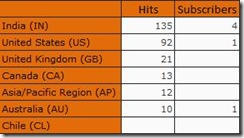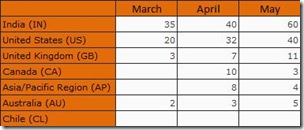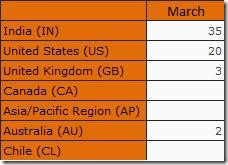【转载】NonEmpty和Non Empty的区别
转载来源:http://www.ssas-info.com/analysis-services-articles/50-mdx/2196-mdx-non-empty-vs-nonempty
One of my favourite questions in MDX is the difference between Non Empty and NonEmpty because even though many people use them daily to remove NULLS from their queries, very few understand the working behind it. Many times, I have even got answers like “there is a space between Non and Empty, that is the difference”. The objective of this post is to clearly differentiate between the two.
Let us say my initial query is
SELECT
{
[Measures].[Hits]
,[Measures].[Subscribers]
,[Measures].[Spam]
} ON COLUMNS
,{
[Geography].[Country].Children
} ON ROWS
FROM [Blog Statistics];
This will give the following output

NON EMPTY
Non Empty is prefixed before the sets defining the axes and is used for removing NULLs. Let us see what happens when we add Non Empty on the Rows axis.
SELECT
{
[Measures].[Hits]
,[Measures].[Subscribers]
,[Measures].[Spam]
} ON COLUMNS
,NON EMPTY
{
[Geography].[Country].Children
} ON ROWS
FROM [Blog Statistics];
The output is shown below

You will notice that Chile (CL) has been filtered out while rows like UK, Canada, etc are still there even if they have NULLs for some of the measures. In short, only the rows having NULL for all the members of the set defined in the column axis is filtered out. This is because the Non Empty operator works on the top level of the query. Internally, the sets defined for the axes are generated first and then the tuples having NULL values are removed. Now that we know how NON EMPTY works, it shouldn’t be hard for us to tell the output of the below query
SELECT
NON EMPTY
{
[Measures].[Hits]
,[Measures].[Subscribers]
,[Measures].[Spam]
} ON COLUMNS
,{
[Geography].[Country].Children
} ON ROWS
FROM [Blog Statistics];
The output is shown below

NONEMPTY()
The NonEmpty() returns the set of tuples that are not empty from a specified set, based on the cross product of the specified set with a second set. Suppose we want to see all the measures related to countries which have a non-null value for Subscribers
SELECT
{
[Measures].[Hits]
,[Measures].[Subscribers]
,[Measures].[Spam]
} ON COLUMNS
,{
NonEmpty
(
[Geography].[Country].Children
,[Measures].[Subscribers]
)
} ON ROWS
FROM [Blog Statistics];
This will give the following output

As you can see, the NonEmpty operator takes all the rows having a not NULL value for Subscribers in the rows and then displays all the measures defined in the column axis. Basically what happens internally is that NonEmpty is evaluated when the sets defining the axis are evaluated. So at this point of time, there is no context of the other axes. What I said now can be better understood from the following example

Now, we write the below query
SELECT
{[Date].[Month].[March]} ON COLUMNS
,{
[Geography].[Country].Children
} ON ROWS
FROM [Blog Statistics]
WHERE
[Measures].[Hits];
Output is given below

Think for a while and predict which all rows would be returned when the NonEmpty operator is applied on the rows
SELECT
{[Date].[Month].[March]} ON COLUMNS
,{
NonEmpty([Geography].[Country].Children)
} ON ROWS
FROM [Blog Statistics]
WHERE
[Measures].[Hits];
If you guessed just IN, US, GB and AU, please go back and read once again. If you replied All rows except Chile, full marks to you, you have been an attentive reader. The reason is because NonEmpty is evaluated when the set defining the axis is evaluated (here, Country) and at that point of time, NonEmpty is evaluated for each member of the country against the default member of the Date dimension (which would be ALL generally). As you can see, we already have values for CA and AP for other months and hence they will not be filtered out.
Optimizing Non Empty by using NonEmpty
Ok, now you know how Non Empty and NonEmpty works internally and we can apply this knowledge to optimize our queries. Suppose there is a complex logic in our axes like finding all the countries that have 30 or more hits in any month. The query is given below
SELECT
{[Measures].[Hits]} ON COLUMNS
,{
Filter
(
[Geography].[Country].Children
*
[Date].[Month].Children
,
[Measures].[Hits] > 30
)
} ON ROWS
FROM [Blog Statistics];
Now my time dimension will have 10 years of data, which means around 120 (10*12) members for the month attribute and my country attribute may have let’s say, 100 members. Now even though I just have 3 months of data for 10 countries for hits, the filter function will need to go through all the combinations of country and month (120*100 combinations). Instead of that, we can just use the NonEmpty operator and bring down the combinations to less than 30 (3 months*10 countries) by using the below query
SELECT
{[Measures].[Hits]} ON COLUMNS
,{
Filter
(
NonEmpty
(
[Geography].[Country].Children
*
[Date].[Month].Children
,[Measures].[Hits]
)
,
[Measures].[Hits] > 30
)
} ON ROWS
FROM [Blog Statistics];
【转载】NonEmpty和Non Empty的区别的更多相关文章
- NonEmpty和Non Empty的区别[转]
One of my favourite questions in MDX is the difference between Non Empty and NonEmpty because even t ...
- 转载:Ajax及 GET、POST 区别
转载:Ajax及 GET.POST 区别 收获: xhr.setRequestHeader(), xhr.getResponseHeader() 可以设置和获取请求头/响应头信息; new FormD ...
- [JS][jQuery]清空元素html("")、innerHTML="" 与 empty()的区别 、remove()区别
清空元素html("").innerHTML="" 与 empty()的区别 一.清空元素的区别 1.错误做法一: $(" ...
- EL表达式中null和empty的区别
下面通过一个例子看看看null和empty的区别,建立一个test.jsp文件,内容如下: <%@page pageEncoding="utf-8" %> name:$ ...
- php 中 isset 和empty 的区别
昨天终于开始学习php了,这个对于我来说听着很熟悉,但是学起来很陌生的东西,尤其是课上能听明白 但是真正写起了手生,都不知道手该往哪里放了,天哪~~~ 其中课上有讲到 isset和empty的区别,现 ...
- [转载]java int与integer的区别
声明: 本篇文章属于转载文章,来源:
- 【转载】new和malloc的区别
本篇随笔为转载,原贴地址:C++中new和malloc的十点区别. 前言 几个星期前去面试C++研发的实习岗位,面试官问了个问题: new与malloc有什么区别? 这是个老生常谈的问题.当时我回答n ...
- C#中string.Empty ,"" , null 区别
引言 String类型作为使用最频繁的类型之一,相信大家都非常熟悉,对于string赋予空值,通常有以下三种方式: String str1=null; String str2=””; String s ...
- PHP isset()与empty()的区别详解
通过对PHP语言的学习,应该知道它是基于函数的一款HTML脚本语言. 庞大的函数库支持着PHP语言功能的实现. 有关PHP函数isset()与empty()的相关用法. PHP的isset()函数 一 ...
随机推荐
- django之配置静态文件
# 别名 STATIC_URL = '/static/' # 配置静态文件,名字必须是STATICFILES_DIRS STATICFILES_DIRS = [ os.path.join(BASE_D ...
- 动态规划:HDU1176-免费馅饼
免费馅饼 Time Limit: 2000/1000 MS (Java/Others) Memory Limit: 65536/32768 K (Java/Others) Total Submi ...
- Java模拟音乐播放器 暂停与重新播放——线程如何控制另外一个线程的状态
package com.example.Thread; import javax.swing.*; import java.awt.*; import java.awt.event.ActionEve ...
- mysql-show processlist之writing to net
mysql提示Writing to net解决 最近发现某一个数据库cpu占用比较过.超过200%了. 首先查看数据库慢日志,设定慢日志5秒,基本上没有产生日,没有超过5秒的语句. show proc ...
- day18 js 正则,UI框架,Django helloworld 以及完整工作流程
JS正则: text 判断字符串是否符合规定的正则表达式 exec 获取匹配的数据 默认情况下: 只要能匹配到就返回true 否则返回false 只匹配数字: 所以J ...
- IOS开发学习笔记036-UIScrollView-循环自动滚动
实现scrollView的自动循环滚动,需要实现几个方法. 其中scrollView中始终保存三张图片,其他的图片在滚动到时再进行加载. 循环的实现主要是在setUpdate 中,如果索引为0是第一个 ...
- 使用 NPC,NPCManager 在 XNA 中创建 NPC(十九)
平方已经开发了一些 Windows Phone 上的一些游戏,算不上什么技术大牛.在这里分享一下经验,仅为了和各位朋友交流经验.平方会逐步将自己编写的类上传到托管项目中,没有什么好名字,就叫 WPXN ...
- [oldboy-django][2深入django]分页功能
1 django自带分页 1.1 分页模板 <!DOCTYPE html> <html lang="en"> <head> <meta c ...
- [oldboy-django][2深入django]FBV + CBV + 装饰器
FBV django CBV & FBV - FBV function basic view a. urls 设置 urls(r'^test.html$', views.test) b. vi ...
- 【翻译】Apache软件基金会1
最近有点看不进去书,所以就找点东西翻译下,正好很想了解Apache基金会都有什么开源项目,每天找点事时间翻译翻译,还可以扩展下视野. 今天就看了两个,第一个是关于.NET的,不再兴趣范围内.第二个还挺 ...
